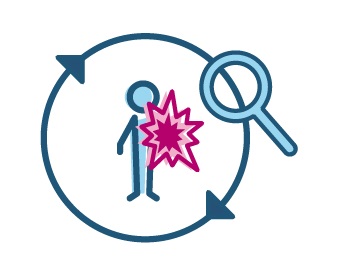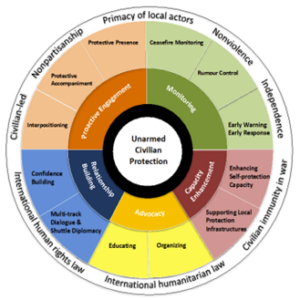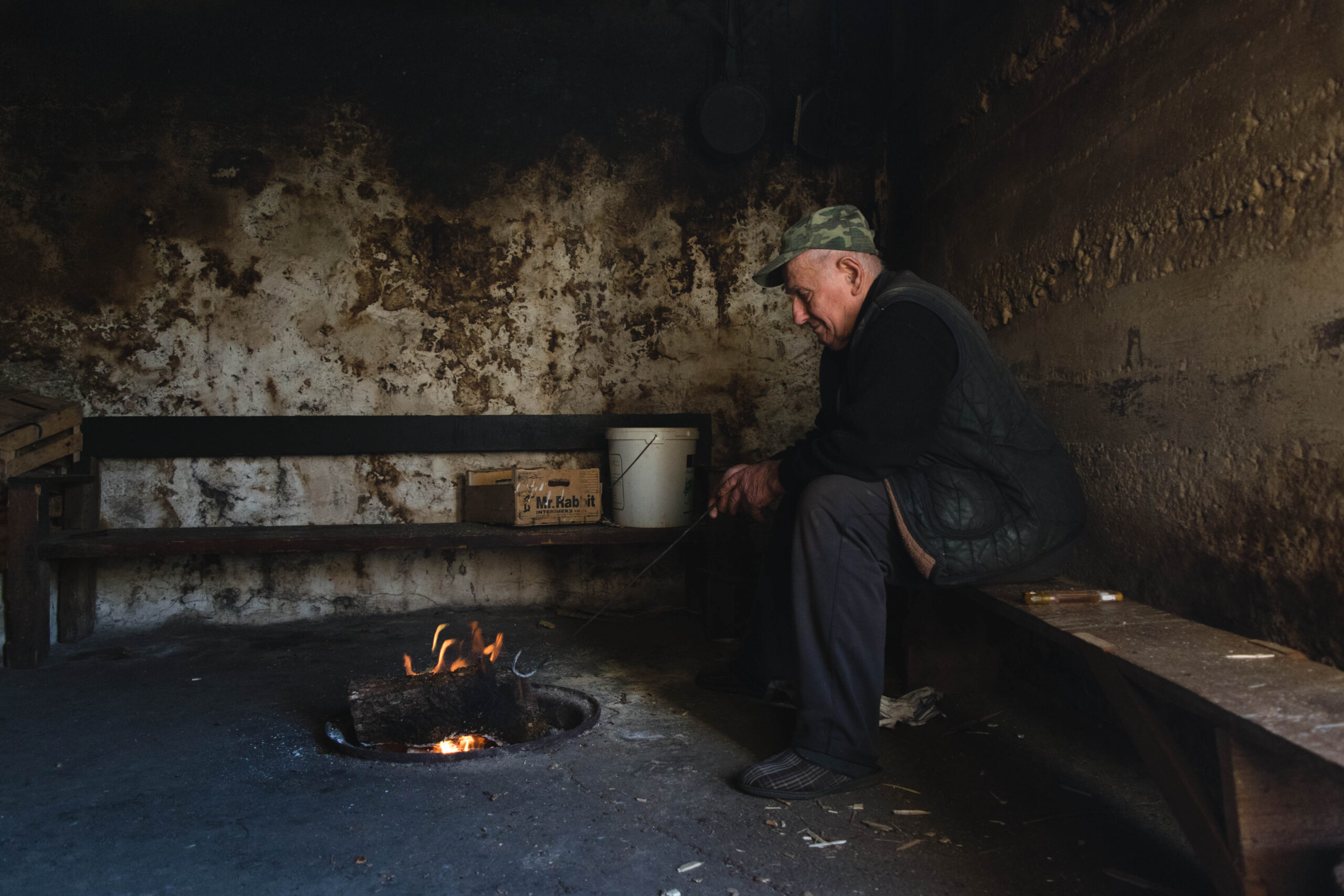 When Nonviolent Peaceforce (NP) first established a presence in southern and eastern Ukraine in April 2022, it arrived without predetermined protection activities, project funding, or an in-country team. While this may have been a daunting prospect for some organizations, this blank slate approach enabled NP to start by engaging with and listening to local first responders already providing emergency protection support to communities. NP didn’t propose specific services that it could provide, nor did it seek to sub-grant to a local implementing partner to deliver those services. Rather, NP asked local organizations about emerging protection risks in the rapidly changing context. NP asked what challenges and gaps they were facing as local associations were being compelled to rapidly scale-up their capacity to address the urgent and growing protection needs.
When Nonviolent Peaceforce (NP) first established a presence in southern and eastern Ukraine in April 2022, it arrived without predetermined protection activities, project funding, or an in-country team. While this may have been a daunting prospect for some organizations, this blank slate approach enabled NP to start by engaging with and listening to local first responders already providing emergency protection support to communities. NP didn’t propose specific services that it could provide, nor did it seek to sub-grant to a local implementing partner to deliver those services. Rather, NP asked local organizations about emerging protection risks in the rapidly changing context. NP asked what challenges and gaps they were facing as local associations were being compelled to rapidly scale-up their capacity to address the urgent and growing protection needs.
 A legal assistance organization, the Tenth of April, which is based in Odessa, highlighted their inability to access people in need of their core services due to protection risks being faced by communities. Although thousands of internally displaced persons (IDPs) in Mykolaiv require civil documentation to obtain banking, humanitarian, and public services, the nearest offices able to process such documents are in Odessa, which is over two hours and many checkpoints away. Many families lack money for transport and fear crossing the checkpoints and encountering unexploded ordnance in transit. Moreover, local organizations were doing more dangerous work, attempting to cross the frontlines and access communities in need—especially the elderly and people living with disabilities—who didn’t want to or weren’t able to relocate. Many organizations didn’t have the proper training or personal protection equipment to uphold their own security policies and keep their staff safe in these conditions.
A legal assistance organization, the Tenth of April, which is based in Odessa, highlighted their inability to access people in need of their core services due to protection risks being faced by communities. Although thousands of internally displaced persons (IDPs) in Mykolaiv require civil documentation to obtain banking, humanitarian, and public services, the nearest offices able to process such documents are in Odessa, which is over two hours and many checkpoints away. Many families lack money for transport and fear crossing the checkpoints and encountering unexploded ordnance in transit. Moreover, local organizations were doing more dangerous work, attempting to cross the frontlines and access communities in need—especially the elderly and people living with disabilities—who didn’t want to or weren’t able to relocate. Many organizations didn’t have the proper training or personal protection equipment to uphold their own security policies and keep their staff safe in these conditions.
These conversations generated the space for NP to collaborate directly with local organizations to design creative initiatives tailored to local needs. NP and the Tenth of April agreed to conduct joint protective accompaniments, each contributing their institutional expertise of unarmed civilian protection (UCP) and legal and administrative support, respectively. To date, NP and the Tenth of April have conducted over 30 accompaniments for over 200 people to access essential legal support and identification documents. As it scaled up, NP provided training on civilian protection not only to its own new teams, but also to local associations and volunteer groups, helping to address capacity gaps faced by local actors and fostering a spirit of collective learning that furthered NP’s acceptance. NP also loaned protective equipment such as bullet-proof vests and helmets to local organizations, trained them on the use of the equipment, and helped them to plan evacuation routes in case of attacks.
Protective accompaniment is a UCP strategy that uses physical presence and visibility to deter violence against or enable access of civilians, often in transit between locations. Presence becomes protective when local people and humanitarian personnel position themselves strategically in locations where civilians face imminent threats or barriers to access. Protective accompaniment often demands deep relationship building to effectively influence local actors to enable civilians to overcome protection risks.
This type of results-based protection would not have been possible without a culture of deep listening, respect, and flexibility. Over the past 20 years, NP has nurtured a distinctive organizational culture that enables it to facilitate space for effective civilian-led protection that empowers communities and prevents local protection risks. At the heart of NP’s work are the following organizational culture enabling factors.
Protection is something that is mutually created from relationships with one another, not something that is provided.
Felicity Gray, Global Head of Policy and Advocacy, Nonviolent Peaceforce
RELATIONSHIP BUILDING
NP teams place a high value on building trusting relationships with communities as a prerequisite for engagement. NP hires its local staff directly from the localities where they work, deliberately targeting individuals who are recognized within the community for their credibility and initiative. NP seeks to build on the positive reputation of its local staff as a critical entry point. International staff also typically live within target communities, reducing the physical and social proximity between the organization and communities. Teams are given the latitude to not only implement structured activities, but also take time for tea with community members, walks around the market, and meetings with local leaders in a way that fosters community acceptance and mutual respect. As a result, communities are more likely to share vital information about changing local dynamics and feedback on programming.
Case Example: In Mundri, South Sudan, NP national protection officers were born and raised in the local community and well-integrated into social networks. When local youth came under attack and had their cattle raided, they quickly alerted NP protection officers, who were able to engage local actors to mobilize the community for collective dialogue to deescalate the situation.
Similarly, NP works to foster trusting relationships internally within its teams. NP aims to hire team members based not only on their technical protection expertise, but also on their interpersonal intelligence, empathy skills, and approach to connecting with others. Teams are integrated between local and international staff with the recognition that each member offers different and complementary skills and perspectives essential to solving problems and responding to protection needs. This integration helps to reduce traditional hierarchies and facilitates team dynamics that enable programmatic creativity and adaptation. Senior management also regularly seeks the perspectives of local staff based in communities as the most credible source of information and makes themselves available to teams in ways that create active feedback loops.
Our actions to stop violence emerge from the creative engagement with communities during crises, even as we design long-term plans. We prioritize practical responses to immediate threats of violence, even as we work to address structural violence. We foster an environment in which communities can re-imagine nonviolent responses to direct physical violence.
Tiffany Easthom, Executive Director, Nonviolent Peaceforce
CONTINUOUS CONTEXT ANALYSIS
Rather than entering communities with a menu of preselected protection services or activities that it can offer, NP conducts context analysis as the basis for the design of all protection activities. NP regularly updates its analysis to ensure that programming continues to respond to emerging developments. Analysis occurs through both dedicated sessions and informal interactions with community stakeholders which inform weekly team meetings and daily updates within the most dynamic crisis contexts to track new trends in incidents of violence. This continuous context analysis is a team-wide practice, engaging not only program staff, but also caretakers, guards, and drivers, who often have the most substantive and timely information and culturally informed analysis. NP strives to integrate its assessment of immediate protection threats with understanding of persistent trends related to safety and peace, balancing a crisis mentality to ensure rapid response with efforts to contribute to long-term change objectives.
Case Example: In Hamam Al-Alil IDP camp in Iraq, NP teams conducted regular Community Security Forums, Women’s and Youth Groups, and mobile night patrols which provided consistent opportunities for residents to engage with NP staff and share their experiences and protection concerns. Sexual and gender-based violence (SGBV) emerged as one of the most pressing issues. This information fueled NP’s context analysis and informed its protection responses. NP realigned the timing of its night patrols to ensure more effective deterrence of SGBV threats, coordinated with camp leadership to identify solutions, and advocated to WASH actors to inform their future installation of hygiene facilities where SGBV was most prevalent.
AGENCY OF LOCAL ACTORS
NP maintains a strong belief that communities experiencing violent conflict are the primary decision makers in terms of which protection issues to prioritize, how to address them, and who to involve in the process. It is an organizational imperative to not only work from the perspective of affected communities, but also provide space for them to assert their own agency. With a spirit of localization that focuses on communities themselves, NP views itself as a team of facilitators, holding space for community participants to design and implement their own solutions, rather than as a group of experts that are providing protection services to beneficiaries. These ideals are consistently reinforced by leadership at all levels from initial onboarding trainings to regular internal analysis and planning discussions. In practice, NP consistently convenes participatory activities with community members to promote deliberation and dialogue that centers communities in the design and ongoing implementation of risk reduction strategies and practices.
FLEXIBLE APPROACHES
 NP trains its teams on a broad spectrum of UCP approaches that can be adapted to diverse contexts and applied at different stages in the conflict cycle as dynamics change. These are not prescriptive programmatic models, but rather flexible strategies that teams and communities can harness depending on local needs and risks. Although new staff may arrive with requests for program manuals that outline activity methodologies and templates, NP encourages its teams to embrace the “spirit of the unknown” to navigate new relationships, analyze contexts, and collaborate with communities to co-design relevant self-protection activities. To this end, NP often seeks to hire staff who not only have protection experience, but also have an appetite for relationship building, collaboration, critical thinking, and adaptation. Very often, these activities directly build on existing local assets and capacities to create new and highly tailored community-based protection tools and approaches.
NP trains its teams on a broad spectrum of UCP approaches that can be adapted to diverse contexts and applied at different stages in the conflict cycle as dynamics change. These are not prescriptive programmatic models, but rather flexible strategies that teams and communities can harness depending on local needs and risks. Although new staff may arrive with requests for program manuals that outline activity methodologies and templates, NP encourages its teams to embrace the “spirit of the unknown” to navigate new relationships, analyze contexts, and collaborate with communities to co-design relevant self-protection activities. To this end, NP often seeks to hire staff who not only have protection experience, but also have an appetite for relationship building, collaboration, critical thinking, and adaptation. Very often, these activities directly build on existing local assets and capacities to create new and highly tailored community-based protection tools and approaches.
Power is something that you hold with other people, rather than over other people.
Felicity Gray, Global Head of Policy and Advocacy, Nonviolent Peaceforce
RESPONSIVENESS TO COMMUNITIES
Rather than accountability flowing upward toward donors or other external strategic interests, NP recognizes civilians as the primary project stakeholders. NP field teams are empowered to make decisions based on changing local needs and context dynamics and senior management is willing to advocate to donors for project adaptations and revisions where needed for teams to effectively respond. Project log frames are often kept intentionally broad in order to create space for community-driven design, rather than tying teams and communities to prescriptive activity descriptions and hard targets. Organizational structures are built not around specific grants, but around geographic areas of intervention, which enables integrated action and further reinforces the buffer between donor expectations and grant requirements, on the one hand, and local protection needs, on the other.
Case Example: Based on its interaction with local organizations in Odessa, NP organized a conference to convene over 40 Ukrainian and 30 international organizations to promote exchange, coordination, and trust building. The event created space for local organizations to share their needs directly with donors and diplomatic actors. The next day, local actors were invited to an OCHA coordination meeting for the first time. Several of the local organizations attending the event also subsequently obtained funding from INGOs and donors.
CLICK HERE TO EXPLORE OTHER CASE EXAMPLES OF RBP IN ACTION
READ MORESign-up
"*" indicates required fields
